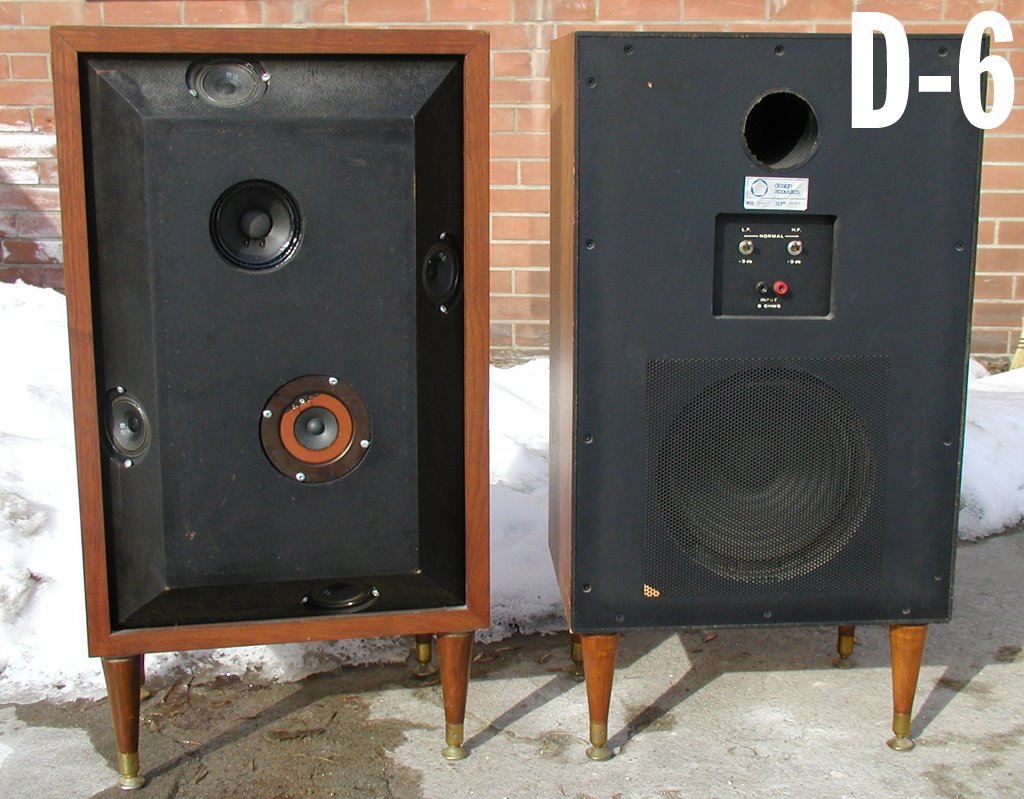KA7NIQ
Member
You may want to read the review and test of these speakers. https://www.stereophile.com/content/dbx-soundfield-1a-loudspeakerIt looks to be a poor omnidirectional speaker, but a great interference machine.
You may want to read the review and test of these speakers. https://www.stereophile.com/content/dbx-soundfield-1a-loudspeakerIt looks to be a poor omnidirectional speaker, but a great interference machine.
i think, "he listened and liked it" was the extent of the review. Not that I'm being negative. If you like the sound, you like it.What test? As far as I can see, Fig. 4 is a concept illustration and not an actual measurement?
This is not really an omnidirectional speaker at all, and perhaps by "interference," you mean directivity control through a phased array, See https://www.linkwitzlab.com/Links/Optimized-listening-area-Davies.pdf. In many ways, this speaker was way ahead of its time.It looks to be a poor omnidirectional speaker, but a great interference machine.
No discussion on Omnidirectional Loudspeakers is complete w/o mentioning these. These are the DBX Soundfield 1A Speakers.
View attachment 222076




Are you trolling ? Just looking at the driver arrangement alone tell us this is an attempt at a more or less Omnidirectional radiator. If you go here https://www.bostonaudiosociety.org/pdf/bass/BASS-17-06-9005.pdf to page 3, there is an entire explanation of the DBX Soundfield 1A Speakers. These speakers were designed by Mark Davis, and there is an entire white paper that was presented to the AES all about them.What test? As far as I can see, Fig. 4 is a concept illustration and not an actual measurement?
Are you trolling ?
Just looking at the driver arrangement alone tell us this is an attempt at a more or less Omnidirectional radiator.
LOL, people who live in Glass Houses should not throw stones, eh ? The speakers of yours displayed in your forum avatar have a driver configuration that really sucks. Side By Side drivers are a big NO NO.It looks to be a poor omnidirectional speaker, but a great interference machine.
Thanks for the link. I'd say it confirms my expectation. There is simply too much distance between the drivers to maintain any type of uniform dispersion. For example, the mids are playing up to 3.15 kHz (wavelength of about 4.3 inches) while they are located on the sides of a box that appear to be at least 14" across. A typical array design will utilize element spacing that's less than 1/2 wavelength. If you look at image 7 in the pdf you'll see some calculations made with questionable resolution, and which still show many nulls (where the plots spike down toward the center). Interestingly, the authors appear to avoid providing the scale for that image even though they provide the scales for most other images. Assuming it follows the 10 dB per division convention, there's a good 12 dB of variation across angle / frequency. Plot 8 shows that there's not really a trend with frequency, which leads me to believe that their calculations show 12 dB variation with angle, away from their idealized dispersion curve (and sometimes more where there are nulls). By varying the levels of each driver, they do make it harder to achieve complete cancellation, and thus they limit the comb filtering effect to some degree.This is not really an omnidirectional speaker at all, and perhaps by "interference," you mean directivity control through a phased array, See https://www.linkwitzlab.com/Links/Optimized-listening-area-Davies.pdf. In many ways, this speaker was way ahead of its time.
Young-Ho
It's been a few decades, but I spent some time listening to a pair back in the days of plentiful brick-and-mortar stores.You may want to read the review and test of these speakers. https://www.stereophile.com/content/dbx-soundfield-1a-loudspeaker
It looks to be a poor omnidirectional speaker, but a great interference machine.
Thanks for the link. I'd say it confirms my expectation. There is simply too much distance between the drivers to maintain any type of uniform dispersion. For example, the mids are playing up to 3.15 kHz (wavelength of about 4.3 inches) while they are located on the sides of a box that appear to be at least 14" across. A typical array design will utilize element spacing that's less than 1/2 wavelength. If you look at image 7 in the pdf you'll see some calculations made with questionable resolution, and which still show many nulls (where the plots spike down toward the center). Interestingly, the authors appear to avoid providing the scale for that image even though they provide the scales for most other images. Assuming it follows the 10 dB per division convention, there's a good 12 dB of variation across angle / frequency. Plot 8 shows that there's not really a trend with frequency, which leads me to believe that their calculations show 12 dB variation with angle, away from their idealized dispersion curve (and sometimes more where there are nulls). By varying the levels of each driver, they do make it harder to achieve complete cancellation, and thus they limit the comb filtering effect to some degree.
It appears that the smoothest, most consistent response happens between the speakers, where no one will be listening. The reasons for this are obvious given the design. Of course, the extra energy used for time-intensity trading will once again yield elevated contralateral reflections... not really my thing. I'd still give them a listen if I knew someone who had them. I'm always curious about unconventional designs.
well, sound quality in this flagship model was a function of EQ (via controller), which you can always modify further following in situ measurementIt's been a few decades, but I spent some time listening to a pair back in the days of plentiful brick-and-mortar stores.
The radiation pattern is shaped to enable time-intensity trading, which in turn enables good imaging and soundstage width across a very wide listening area. I remember sitting to the outside of one of the speakers, well beyond what might be considered the normal listening area, and I was still hearing a decent and enjoyable spread of instruments in between the speakers. Sadly the sound quality (as opposed to the spatial quality) was imo not competitive for its price range at the time, in my opinon. It's not easy to be at the forefront of both sound quality and spatial quality in a given price range.
Harold Beveridge's electrostatics with their lensed enclosures had a similar radiation pattern (each speaker's well-behaved 150-degree-wide pattern facing the other speaker), and also soundstaged well across an extraordinarily wide range of listening positions when set-up as recommended. I heard them with each speaker on an opposite wall, facing one another, and the sound images occupied the other end of the room. It was a memorable demonstration.
One of Harold Beveridges's former employees, Sean McCaughan, went on to start a speaker company called ESP and one of his more recent designs, the "Double Bass", was essentially a direct-radiator incarnation of Harold Beveridges's ideas about loudspeaker radiation patterns. It was one of the best-sounding loudspeakers I have ever heard, particularly notable for its rare combination of image precision and envelopment, and its utter lack of distracting artifacts, but I don't think it was a commercial success.
...well, more correctly, "...is a consequence of its radiation pattern."
I tried mageplaners. I don't want a head vice sweetspot. I don't want a 100 lb power amp with a 30 amp circuit to drive them. I don't want to hopelessly integrate a subwoofer with a speaker that cannot produce meaningful base below 200 hz. I am not a basehead.Planar and electrostatic are very far from being an omni point source. The polar pattern is a series of lobes centered on each side, that get quite byzantine at higher frequencies.
Thank goodness. So far ahead you can longer find it. History Channel material.This is not really an omnidirectional speaker at all, and perhaps by "interference," you mean directivity control through a phased array, See https://www.linkwitzlab.com/Links/Optimized-listening-area-Davies.pdf. In many ways, this speaker was way ahead of its time.
Young-Ho
GooglygookThe dbx SF line was omni but not **equi-omni** --- that's the whole point of shaping the oval hor radpat to a listener purpose.
The DA and other knockoffs were not particularly successful in the listening --- Bose launched a few and stole the dbx Stereo Everywhere tagline, and we did not have the resources to pursue --- but Canon and a few others at the very end of dbx, also including dbx, were embarking on lensed horns (like Moulton's superb work for B&O) with the goal of wider listening area stereo. Controlling the high resonances within that resonator was near impossible before DSP then.
The most serious and successful attempt at the dbx SF achievement was the Allison IC20, a stupendous loudspeaker with no precision shaping, just a panel adjust to distance-level trade, but with the unmatched (still unmatched) Allison mid and tweeter, precision was not necessary. That was and is a large design worth auditioning if you ever get a chance.
It was Mark Davis in the mid-1970s, as MIT doctoral student in EE/psychoacoustics, who pronounced (knowing full well that it was not an original thought with him, but only select Canadian researchers were working in the same area at the time) that "what we hear from a speaker in an enclosed space IS its radiation pattern."
slur aside, you need to pay more attention, to think such a thing, AliceThank goodness. So far ahead you can longer find it. History Channel material.
